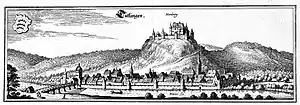Battle of Tuttlingen
The Battle of Tuttlingen was fought in Tuttlingen on 24 November 1643. Involved in the conflict was on one side the French army in Germany led by Marshal Josias Rantzau, composed of French soldiers and the so called Weimarans or Bernhardines, German troops once in service of Bernard of Saxe-Weimar. Its contrahent was the army of the Holy Roman Empire led by Franz von Mercy. Technically, Mercy led a military force composed of his Bavarian army, supported by Imperial, Spanish, and Lorrainer troops.
| Battle of Tuttlingen | |||||||
|---|---|---|---|---|---|---|---|
| Part of Thirty Years' War | |||||||
 Tuttlingen in 1643 | |||||||
| |||||||
| Belligerents | |||||||
|
|
| ||||||
| Commanders and leaders | |||||||
|
|
| ||||||
| Strength | |||||||
| 15,000 |
15,000–18,000[1] 10 guns | ||||||
| Casualties and losses | |||||||
|
7,000–11,000[1]
| |||||||
In early November the French-Weimarian forces had besieged Rottweil to secure winter quarters along the Danube at Tuttlingen. They captured Rottweil on 18 November but their commander Guébriant was mortally wounded in the siege. His successor Rantzau who just had arrived with reinforcements from Lorraine was despised by officers who originated from the former German army of Bernard of Saxe-Weimar. Outlying detachments of the French were posted at Mühlingen and Möhringen. With the French inactive and himself reinforced by Imperial troops under Hatzfeld and Lorrainer troops under the exiled Duke Charles, Mercy convinced the other generals to a surprise attack on the French encampment. To maximize surprise, the Imperials approached from the south-east instead of further to the north where the Danube and the French garrison at Rottweil blocked their way.[2]
At mid-afternoon on 24 November, Johann von Werth led 2,000 cavalry in the first assault group against Möhringen and achieved instant success, riding down a French infantry regiment composed of Spanish prisoners of war. The Bavarian dragoons captured the French pickets posted near Tuttlingen, allowing the Imperials to seize with minimal opposition the lightly defended French artillery park in the cemetery outside town. The Weimarian cavalry in Mühlheim under Reinhold von Rosen attempted to reinforce the French at Tuttlingen but were intercepted and defeated by Mercy's brother Kaspar. Kaspar then destroyed the Weimarian infantry remaining at Mühlheim.[2]
The French cavalry now fled the scene. The captured guns were used to bombard the helpless French infantry in Tuttlingen and Möhringen, who capitulated the next day along with their commander Rantzau. The fighting lasted for a day and a half, not so much due to the effectiveness of Franco-Weimarian resistance but because of the disorganized and isolated nature of their detachments. The 2,000 strong French garrison in Rottweil surrendered a week later.[2]
Rantzau's army largely ceased to exist, the remnants retreating back across the Rhine River into Alsace.[3] Moreover, Mercy held Rantzau, seven other generals, 9 colonels, 10 guns, the whole baggage and seven thousand French troops captive. Another 4,000 lay dead or wounded. The Weimarian army was permanently crippled by this disaster.
See also
References
- Bodart 1916, p. 85.
- Wilson 2009, p. 642-643.
- Croxton, pp. 981, 987.
Sources
- Bodart, G. (1916). Losses of Life in Modern Wars, Austria-Hungary; France. ISBN 978-1371465520.CS1 maint: ref=harv (link)
- Croxton, Derek. "The Prosperity of Arms Is Never Continual: Military Intelligence, Surprise, and Diplomacy in 1640s Germany." The Journal of Military History, Vol. 64, No. 4 (October 2000), pp. 981-1003.
- Wilson, Peter H. (2009). Europe's Tragedy: A History of the Thirty Years War. Allen Lane. ISBN 978-0-7139-9592-3.